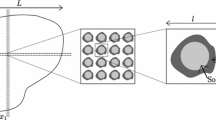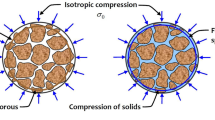Abstract
The permeability of magmas to percolating fluids plays a role in controlling eruption explosivity. While measurements of volcanic rock permeability abound, comparison of these values with models that relate hydraulic properties to random heterogeneous pore structures are few. Here, we present such a comparison. First, we generate numerical materials composed of randomly placed spherical objects in a periodic control volume using two dominant pore structure families: (1) where the space between the spherical objects represents the pore phase that can transmit fluid, and (2) where the spherical objects themselves are the pore phase that can transmit fluid. In the former case, we envisage the system to be analogous to initially granular magmas that undergo welding events that serve to progressively reduce the porosity. In the latter case, we envisage the system to be analogous to vesiculating magmas that evolve to high porosities. In both cases, we constrain relationships for fundamental structural parameters for every porosity including the specific surface area and the percolation thresholds and we compare these with theoretical relationships. Importantly, we run lattice Boltzmann method simulations of fluid flow through these systems at a wide range of porosities to constrain the steady state Darcian fluid permeability using the LBflow code. We finally compare these permeability values with (1) other published simulations, (2) published permeability data for natural volcanic rocks or experimental analogues thereof, and (3) theoretical constraints derived from first principles. In all cases, we obtain a good agreement between our idealized numerical random systems and the natural data, as well as results of other theoretical and experimental approaches. We propose that the simple models that we derive and validate can be of wide utility in building more complex models for the evolution of magmas during shallow ascent with broad implications for outgassing efficiency and the development of pore overpressure immediately prior to eruption.











Similar content being viewed by others
References
Blair SC, Berge PA, Berryman JG (1993) Two-point correlation functions to characterize microgeometry and estimate permeabilities of synthetic and natural sandstones. Lawrence Livermore National Lab, CA (United States)
Blower JD (2001a) Factors controlling permeability–porosity relationships in magma. Bull Volcanol 63:497–504
Blower JD (2001b) A three-dimensional network model of permeability in vesicular material.
Brunauer S, Emmett PH, Teller E (1938) Adsorption of gases in multimolecular layers. J Am Chem Soc 60:309–319. https://doi.org/10.1021/ja01269a023
Burgisser A, Chevalier L, Gardner JE, Castro JM (2017) The percolation threshold and permeability evolution of ascending magmas. Earth Planet Sci Lett 470:37–47
Collinson ASD, Neuberg JW (2012) Gas storage, transport and pressure changes in an evolving permeable volcanic edifice. J Volcanol Geotherm Res 243–244:1–13. https://doi.org/10.1016/j.jvolgeores.2012.06.027
Colombier M, Wadsworth FB, Gurioli L et al (2017) The evolution of pore connectivity in volcanic rocks. Earth Planet Sci Lett 462:99–109
Degruyter W, Bachmann O, Burgisser A (2010) Controls on magma permeability in the volcanic conduit during the climactic phase of the Kos Plateau Tuff eruption (Aegean Arc). Bull Volcanol 72:63–74
Diller K, Clarke AB, Voight B, Neri A (2006) Mechanisms of conduit plug formation: implications for vulcanian explosions. Geophys Res Lett 33:L20302. https://doi.org/10.1029/2006gl027391
Eichelberger JC, Carrigan CR, Westrich HR, Price RH (1986) Non-explosive silicic volcanism. Nature 323:598–602
Elam WT, Kerstein AR, Rehr JJ (1984) Critical properties of the void percolation problem for spheres. Phys Rev. Lett 52:1516
Farquharson J, Heap MJ, Varley NR et al (2015) Permeability and porosity relationships of edifice-forming andesites: a combined field and laboratory study. J Volcanol Geotherm Res 297:52–68
Feng S, Halperin BI, Sen PN (1987) Transport properties of continuum systems near the percolation threshold. Phys Rev. B 35:197
Fiorio C, Gustedt J (1996) Two linear time union-find strategies for image processing. Theor Comput Sci 154:165–181
Garboczi EJ, Snyder KA, Douglas JF, Thorpe MF (1995) Geometrical percolation threshold of overlapping ellipsoids. Phys Rev. E 52:819
Gonnermann HM, Manga M (2007) The fluid mechanics inside a volcano. Annu Rev Fluid Mech 39:321–356. https://doi.org/10.1146/annurev.fluid.39.050905.110207
Halperin BI, Feng S, Sen PN (1985) Differences between lattice and continuum percolation transport exponents. Phys Rev. Lett 54:2391
Hasimoto H (1959) On the periodic fundamental solutions of the Stokes equations and their application to viscous flow past a cubic array of spheres. J Fluid Mech 5:317–328
Heap MJ, Farquharson JI, Wadsworth FB et al (2015) Timescales for permeability reduction and strength recovery in densifying magma. Earth Planet Sci Lett 429:223–233
Heap MJ, Kennedy BM (2016) Exploring the scale-dependent permeability of fractured andesite. Earth Planet Sci Lett 447:139–150
Kendrick JE, Lavallée Y, Hess K-U et al (2013) Tracking the permeable porous network during strain-dependent magmatic flow. J Volcanol Geotherm Res 260:117–126. https://doi.org/10.1016/j.jvolgeores.2013.05.012
Kertesz J (1981) Percolation of holes between overlapping spheres: Monte Carlo calculation of the critical volume fraction. J Phys Lettres 42:393–395
Klug C, Cashman KV (1996) Permeability development in vesiculating magmas: implications for fragmentation. Bull Volcanol 58:87–100
Lewiner T, Lopes H, Vieira AW, Tavares G (2003) Efficient implementation of marching cubes’ cases with topological guarantees. J Graph Tools 8:1–15
Llewellin EW (2010a) LBflow: an extensible lattice Boltzmann framework for the simulation of geophysical flows. Part II: usage and validation. Comput Geosci 36:123–132
Llewellin EW (2010b) LBflow: an extensible lattice Boltzmann framework for the simulation of geophysical flows. Part I: theory and implementation. Comput Geosci 36:115–122
Lorensen WE, Cline HE (1987) Marching cubes: a high resolution 3D surface construction algorithm. ACM siggraph Comput Graph 21:163–169
Lorenz B, Orgzall I, Heuer HO (1993) Universality and cluster structures in continuum models of percolation with two different radius distributions. J Phys A Math Gen 26:4711
Lorenz CD, Ziff RM (2001) Precise determination of the critical percolation threshold for the three-dimensional “Swiss cheese” model using a growth algorithm. J Chem Phys 114:3659–3661
Martys NS, Torquato S, Bentz DP (1994) Universal scaling of fluid permeability for sphere packings. Phys Rev E 50:403
Melnik O, Barmin AA, Sparks RSJ (2005) Dynamics of magma flow inside volcanic conduits with bubble overpressure buildup and gas loss through permeable magma. J Volcanol Geotherm Res 143:53–68
Mueller S, Melnik O, Spieler O et al (2005) Permeability and degassing of dome lavas undergoing rapid decompression: an experimental determination. Bull Volcanol 67:526–538. https://doi.org/10.1007/s00445-004-0392-4
Mueller S, Scheu B, Spieler O, Dingwell DB (2008) Permeability control on magma fragmentation. Geology 36:399–402
Nabovati A, Llewellin EW, Sousa ACM (2009) A general model for the permeability of fibrous porous media based on fluid flow simulations using the lattice Boltzmann method. Compos Part A Appl Sci Manuf 40:860–869
Okumura S, Sasaki O (2014) Permeability reduction of fractured rhyolite in volcanic conduits and its control on eruption cyclicity. Geology 42:843–846
Polacci M, Baker DR, Mancini L et al (2006) Three-dimensional investigation of volcanic textures by X-ray microtomography and implications for conduit processes. Geophys Res Lett 33:L13312. https://doi.org/10.1029/2006GL026241
Quintanilla JA, Torquato S, Ziff RM (2000) Efficient measurement of the percolation threshold for fully penetrable discs. J Phys A Math Gen 33:L399
Quintanilla JA, Ziff RM (2007) Asymmetry in the percolation thresholds of fully penetrable disks with two different radii. Phys Rev E 76:51115
Rintoul MD (2000) Precise determination of the void percolation threshold for two distributions of overlapping spheres. Phys Rev E 62:68
Rintoul MD, Torquato S (1996) Computer simulations of dense hard-sphere systems. J Chem Phys 105:9258–9265. https://doi.org/10.1063/1.473004
Rintoul MD, Torquato S (1997) Precise determination of the critical threshold and exponents in a three-dimensional continuum percolation model. J Phys A Math Gen 30:L585
Rust AC, Cashman KV (2004) Permeability of vesicular silicic magma: inertial and hysteresis effects. Earth Planet Sci Lett 228:93–107
Rust AC, Cashman KV (2011) Permeability controls on expansion and size distributions of pyroclasts.
Rust AC, Cashman KV, Wallace PJ (2004) Magma degassing buffered by vapor flow through brecciated conduit margins. Geology 32:349–352
Saar MO, Manga M (1999) Permeability-porosity relationship in vesicular basalts. Geophys Res Lett 26:111–114. https://doi.org/10.1029/1998GL900256
Sangani AS, Acrivos A (1982) Slow flow through a periodic array of spheres. Int J Multiph Flow 8:343–360. https://doi.org/10.1016/0301-9322(82)90047-7
Torquato S (2013) Random heterogeneous materials: Microstructure and macroscopic properties. Springer Science & Business Media.
Torquato S, Lu B (1990) Rigorous bounds on the fluid permeability: effect of polydispersivity in grain size. Phys Fluids A Fluid Dyn 2:487–490
Wadsworth FB, Vasseur J, Llewellin EW et al (2017) Topological inversions in coalescing granular media control fluid-flow regimes. Phys Rev E 96:33113. https://doi.org/10.1103/PhysRevE.96.033113
Wadsworth FB, Vasseur J, Scheu B et al (2016) Universal scaling of fluid permeability during volcanic welding and sediment diagenesis. Geology 44:219–222. https://doi.org/10.1130/G37559.1
Westrich HR, Eichelberger JC (1994) Gas transport and bubble collapse in rhyolitic magma: an experimental approach. Bull Volcanol 56:447–458
Wright HM, Cashman KV (2014) Compaction and gas loss in welded pyroclastic deposits as revealed by porosity, permeability, and electrical conductivity measurements of the Shevlin Park Tuff. Geol Soc Am Bull 126:234–247. https://doi.org/10.1130/b30668.1
Wright HM, Cashman KV, Gottesfeld EH, Roberts JJ (2009) Pore structure of volcanic clasts: measurements of permeability and electrical conductivity. Earth Planet Sci Lett 280:93–104
Wu K, Otoo E, Shoshani A (2005) Optimizing connected component labeling algorithms.
Acknowledgments
We are grateful to Ed Llewellin for providing the source code for LBflow (http://www.lbflow.co.uk) and for much stimulating discussion, and to Salvatore Torquato for patiently answering our questions. Mathieu Colombier provided invaluable assistance with our 3D visualization in Fig. 2. We also thank the Leibniz Supercomputing Centre of the Bavarian Academy of Sciences and Humanities for computational support. We additionally thank two anonymous reviewers, as well as Jamie Farquharson, Josef Dufek and Andrew Harris for comments on the manuscript.
Author information
Authors and Affiliations
Corresponding author
Additional information
Editorial responsibility: J. Dufek
Rights and permissions
About this article
Cite this article
Vasseur, J., Wadsworth, F.B. Sphere models for pore geometry and fluid permeability in heterogeneous magmas. Bull Volcanol 79, 77 (2017). https://doi.org/10.1007/s00445-017-1165-1
Received:
Accepted:
Published:
DOI: https://doi.org/10.1007/s00445-017-1165-1




